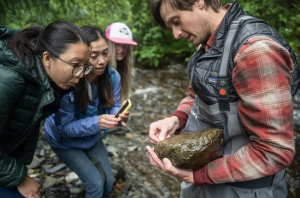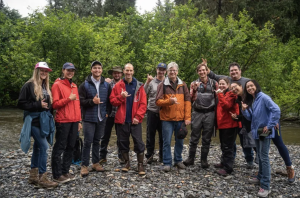Research across the Pacific: PI-AK scientists meet in Juneau
This story was originally written by AK CASC science communications specialist Molly Tankersley and published on the PI-AK website on August 16, 2022.
On the banks of Montana Creek in Juneau, Alaska, a group clad in colorful rain gear watches expectantly as AK CASC graduate student Kevin Fitzgerald empties a throng of juvenile salmon from a small wire trap. His audience has traveled across the Pacific from Hawaiʻi to observe stream research in Alaskan watersheds and compare methodologies for a cross-regional effort as part of the Pacific Islands-Alaska CASC Collaboration.
Fitzgerald’s research on the effect of streamflow on growth patterns of salmon is mirrored by work from PI-CASC student Danielle Bartz, who is using similar methods to study the impact of streamflow conditions on invasive suckermouth catfish on Hawaiʻi’s O’ahu island. Their joint research is one of several linked projects that the group of researchers, students, and staff from the PI-AK Collaboration came together to discuss in late July 2022 at the Juneau Forestry Sciences Laboratory. The three-day meeting was an opportunity for principal investigators, staff, and graduate students to share their findings, compare fieldwork sites and methods firsthand, and discuss a shared vision for the collaboration.
For the visiting PI-CASC researchers, the similarities between their home region and the steep coastal watersheds of Southeast Alaska were as profound as the differences.
“Hawaiʻi and southeast Alaska both have indigenous communities which are closely tied to their environment, and ensuring the health of the environment is paramount to them in the face of climate change and development. Both locations are volcanic, with steep slopes, and short river systems that rapidly transport watershed materials from the ridge to the ocean. Also, both locations receive a lot of rain and have rainforest vegetation. We noticed that our raincoats, which claim to be waterproof, only stayed dried for a while in Juneau; this also occurs in Hawaiʻi when we have torrential rain,” said PI-CASC research Tracy Wiegner. Wiegner is studying changing hydrologic conditions in Hawaiʻi and how land-use practices are altering stream discharge and nearshore marine health and productivity.

“One thing I’ve been thinking about is how the role of the streams and their importance to local communities differs. In Hawaiʻi, streams are not thought of in the same way as in southeast Alaska, where they are critical habitat for an economically and culturally important fish (salmon). In Hawaiʻi, the focus is on catching fish in the estuary and offshore to feed families,” said Wiegner.
The seven pilot projects funded through the PI-AK Collaboration aim to aid community-based adaptation in each region by growing regional capacity while developing science, equivalent knowledge, and management approaches to adapt to climate change.
“On the surface, the Pacific Islands and southeast Alaska are very different places, but actually they face the same challenges in terms of having islanded communities and lack of detailed climate and environmental data, and they are similar in terms of having steep and rugged mountains, lots of rain, tight linkages between terrestrial watersheds and coastal ecosystems, robust Indigenous communities, knowledge systems, and ways of living, and a strong reliance on ecosystem services for food and recreation. We are hoping that we can learn from each other on how to best support community-based adaptation efforts through research and communication in these two regions,” said AK CASC researcher Allison Bidlack.
As the group’s time together ended, future meetings, collaboration opportunities, and research priorities filled the conversation. The PI-AK Collaboration will continue to expand cross-regional research and information sharing, with additional projects funded to inform adaptation and natural resource management in Alaska and Pacific Islands watersheds.


